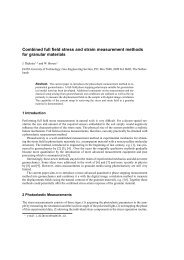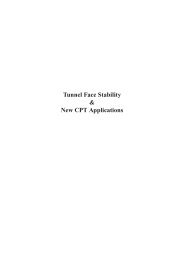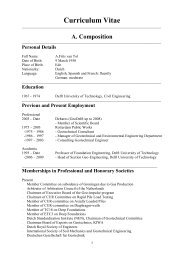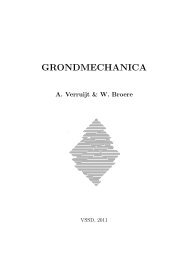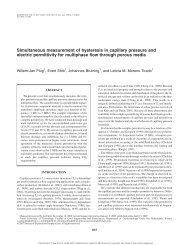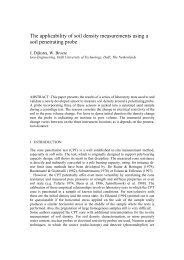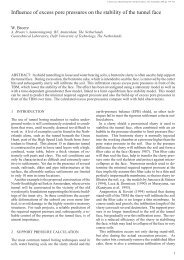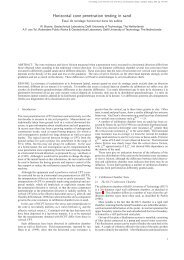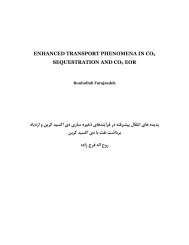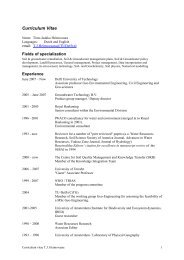Overview of Geotechnical Physical Modelling ... - Geo-Engineering
Overview of Geotechnical Physical Modelling ... - Geo-Engineering
Overview of Geotechnical Physical Modelling ... - Geo-Engineering
Create successful ePaper yourself
Turn your PDF publications into a flip-book with our unique Google optimized e-Paper software.
15 th ICSMGE: Istanbul 2001<br />
TC2 Workshop - Session W7<br />
<strong>Overview</strong> <strong>of</strong> <strong><strong>Geo</strong>technical</strong> <strong>Physical</strong><br />
<strong>Modelling</strong><br />
Pr<strong>of</strong>essor Mark Randolph<br />
Special Research Centre for Offshore Foundation Systems 1<br />
The University <strong>of</strong> Western Australia<br />
1<br />
Established and supported under the Australian Research Council’s Research Centres Program
Outline<br />
• <strong>Modelling</strong> in Design<br />
− formulation <strong>of</strong> conceptual models<br />
• Why <strong>Physical</strong> <strong>Modelling</strong> <br />
• Soil Characterisation<br />
• Examples<br />
15th ICSMG<br />
Istanbul, August 2001
Contribution <strong>of</strong> <strong>Modelling</strong> to Design<br />
Rigorous<br />
numerical<br />
analysis<br />
Data from<br />
full-scale<br />
events<br />
Validation <strong>of</strong><br />
modelling<br />
techniques<br />
Design<br />
Calibration <strong>of</strong><br />
conceptual<br />
model<br />
<strong>Physical</strong><br />
model<br />
Demonstration <strong>of</strong><br />
applicability<br />
Conceptual<br />
model<br />
15th ICSMG<br />
Istanbul, August 2001
Verification <strong>of</strong> Conceptual Models<br />
Two different categories:<br />
• Simplified Analytical Models<br />
− e.g. approximate elastic solutions; plastic limit analyses<br />
− generally, must validate through rigorous numerical<br />
analysis, NOT through physical modelling<br />
• Correlations with Soil Parameters<br />
− e.g. pile shaft friction; limiting vane torque; bearing<br />
'capacity' in compressible granular materials<br />
− essential to mimic typical (prototype) measurement <strong>of</strong><br />
key soil properties for correlations<br />
15th ICSMG<br />
Istanbul, August 2001
Why <strong>Physical</strong> <strong>Modelling</strong> <br />
• Complexity <strong>of</strong> Soil Response<br />
− particle crushing, destructuring (e.g. cemented soils)<br />
− (strength) anisotropy, strain s<strong>of</strong>tening (shear bands)<br />
− cyclic loading, creep<br />
• Complexity <strong>of</strong> <strong>Geo</strong>metry or Construction<br />
− pile installation: jacked, driven, bored<br />
− large penetration (e.g. drag anchors, caissons)<br />
− tunnelling (), deep excavation/retaining walls ()<br />
• New Phenomena<br />
− e.g. fundamental soil response; thermomechanical or<br />
chemical interactions<br />
15th ICSMG<br />
Istanbul, August 2001
Soil Characterisation in Model Testing<br />
• For conceptual model development, essential to<br />
plan soil characterisation studies as integrated<br />
part <strong>of</strong> model testing<br />
− spatial variation <strong>of</strong> strength (3-D)<br />
− temporal variation in strength<br />
• Clays<br />
− penetrometer testing (cone, T-bar etc), vane ()<br />
• Sands<br />
− cone, buried samplers (void ratio), G o measurements<br />
15th ICSMG<br />
Istanbul, August 2001
Examples<br />
• Micro-structural response <strong>of</strong> sands during pile<br />
installation<br />
− courtesy <strong>of</strong> White/Bolton experimental studies<br />
− particle crushing, consequential stress changes<br />
• Complex piled raft foundation study<br />
− consolidation <strong>of</strong> s<strong>of</strong>t clay using wick drains<br />
− conditioning <strong>of</strong> clay by drawing down water table<br />
− incremental loading <strong>of</strong> piled and unpiled foundations<br />
15th ICSMG<br />
Istanbul, August 2001
0<br />
1<br />
Local shear stress, τ s (kPa)<br />
0 10 20 30 40 50 60<br />
Friction Fatigue: Data<br />
Measured in the field<br />
Observed in the lab<br />
2<br />
3<br />
4<br />
5<br />
6<br />
h/D= 25<br />
h/D= 14<br />
h/D= 4<br />
Instrumented steel pile<br />
Diameter, D = 102 mm<br />
h/D= 25<br />
Instrument cluster<br />
h/D= 14<br />
h/D= 4<br />
Distance from pile tip, h<br />
Lehane, 1992<br />
From Lehane et al (1993)<br />
UNIVERSITY OF<br />
CAMBRIDGE<br />
Mechanism: Horizontal compression around base creates<br />
high horizontal stress on pile shaft. Subsequent shearing<br />
leads to unloading and reduced horizontal stress.<br />
Courtesy <strong>of</strong> David White, CUEL
Friction Fatigue: Challenge<br />
How can this behaviour be modelled (and predicted)<br />
Initial conditions:<br />
Stress path: Up to 2 MPa and<br />
back to a few kPa<br />
Strain path: shear strain > 100%<br />
volumetric strain > 30%<br />
Unbroken soil<br />
Shear zone<br />
Pile<br />
Stiffness <br />
10 mm Grain size = <br />
Roughness height = <br />
Shear zone: D 50 reduced by<br />
factor <strong>of</strong> 2 within 3 mm <strong>of</strong> pile.<br />
Zone <strong>of</strong> fines able to migrate<br />
into voids in far field.<br />
UNIVERSITY OF<br />
CAMBRIDGE<br />
Courtesy <strong>of</strong> David White, CUEL
Foundations on S<strong>of</strong>t Clay<br />
Objective<br />
Courtesy Dr Hackmet Joer, UWA<br />
• Evaluate relative merits <strong>of</strong> alternative piling schemes and<br />
conditioning <strong>of</strong> s<strong>of</strong>t (n.c.) clay by drawdown <strong>of</strong> water table<br />
Unpiled raft<br />
Piled raft<br />
sand<br />
surcharge<br />
s<strong>of</strong>t<br />
clay<br />
PPT<br />
PPT<br />
PPT<br />
PPT<br />
PPT<br />
PPT<br />
27 mm33 mm<br />
25 mm<br />
30 mm<br />
127<br />
mm<br />
192 mm<br />
sand<br />
layer<br />
PPT<br />
PPT<br />
wick<br />
drains<br />
162.5<br />
mm<br />
162.5<br />
mm<br />
650 mm<br />
162.5<br />
mm<br />
15th ICSMG<br />
Istanbul, August 2001
Site Investigation: T-bar Tests<br />
Prototype penetration (m)<br />
T-Bar Resistance (MPa)<br />
-2 0 2 4 6 8<br />
0<br />
Test 1-1<br />
Test 1-2<br />
5<br />
Test 2-1<br />
Test 2-2<br />
Upper Clay Test 3-1<br />
10<br />
Test 3-2<br />
Linear fit<br />
15<br />
Middle sand layer<br />
20<br />
Six tests in 3 separate samples:<br />
Upper clay:<br />
Resistance pr<strong>of</strong>ile <strong>of</strong> 25 kPa/m<br />
ds u /dz = 2.4 kPa/m (N t = 10.5)<br />
Middle sand:<br />
Peak resistance <strong>of</strong> 5 to 6 MPa<br />
N q <strong>of</strong> about 100 (6 T-bar Ø)<br />
25<br />
30<br />
Lower Clay<br />
Lower clay:<br />
High resistance due to sand<br />
carried into clay by T-bar<br />
15th ICSMG<br />
Istanbul, August 2001
Installation <strong>of</strong> Wick Drains<br />
15th ICSMG<br />
Istanbul, August 2001
Finished Wick Drains<br />
15th ICSMG<br />
Istanbul, August 2001
Loading Device - Schematic<br />
• Independent loading<br />
<strong>of</strong> each foundation<br />
• 4 loading increments<br />
(max <strong>of</strong> 100 kPa)<br />
• Separate weights<br />
linked by sliding rods<br />
• Central and edge<br />
settlement measured<br />
Displacement<br />
transducer<br />
Weights<br />
Raft<br />
Strongbox<br />
Loading frame<br />
Actuator<br />
Displacement<br />
transducer<br />
162.5 mm<br />
325 mm<br />
162.5 mm<br />
15th ICSMG<br />
Istanbul, August 2001
Loading Device - Photographs<br />
15th ICSMG<br />
Istanbul, August 2001
Settlement Response During Loading<br />
• Wick drains functioned well, leading to much<br />
faster consolidation<br />
• Drawdown <strong>of</strong> water table was shown to be<br />
effective in reducing settlements to 20 % <strong>of</strong><br />
those without drawdown<br />
• Detailed modelling <strong>of</strong> different pile geometries<br />
and drawdown strategies was effective in<br />
assessing an appropriate design approach<br />
15th ICSMG<br />
Istanbul, August 2001
Discussion Issues<br />
• <strong>Physical</strong> <strong>Modelling</strong><br />
− What rôle does it have in development <strong>of</strong> conceptual<br />
models for design<br />
• Micro-structural Response<br />
− New techniques to quantify micro-structural response<br />
during construction processes<br />
− Can we make quantitative links for use in design<br />
models<br />
• Complex Problems<br />
− Are we kidding ourselves that our (scaled) results are<br />
a good guide to prototype performance<br />
15th ICSMG<br />
Istanbul, August 2001



